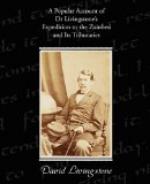The Zambesi pours its waters into the ocean by four mouths, namely, the Milambe, which is the most westerly, the Kongone, the Luabo, and the Timbwe (or Muselo). When the river is in flood, a natural canal running parallel with the coast, and winding very much among the swamps, forms a secret way for conveying slaves from Quillimane to the bays Massangano and Nameara, or to the Zambesi itself. The Kwakwa, or river of Quillimane, some sixty miles distant from the mouth of the Zambesi, has long been represented as the principal entrance to the Zambesi, in order, as the Portuguese now maintain, that the English cruisers might be induced to watch the false mouth, while slaves were quietly shipped from the true one; and, strange to say, this error has lately been propagated by a map issued by the colonial minister of Portugal.
After the examination of three branches by the able and energetic surveyor, Francis Skead, R.N., the Kongone was found to be the best entrance. The immense amount of sand brought down by the Zambesi has in the course of ages formed a sort of promontory, against which the long swell of the Indian Ocean, beating during the prevailing winds, has formed bars, which, acting against the waters of the delta, may have led to their exit sideways. The Kongone is one of those lateral branches, and the safest; inasmuch as the bar has nearly two fathoms on it at low water, and the rise at spring tides is from twelve to fourteen feet. The bar is narrow, the passage nearly straight, and, were it buoyed and a beacon placed on Pearl Island, would always be safe to a steamer. When the wind is from the east or north, the bar is smooth; if from the south and south-east, it has a heavy break on it, and is not to be attempted in boats. A strong current setting to the east when the tide is flowing, and to the west when ebbing, may drag a boat or ship into the breakers. If one is doubtful of his longitude and runs east, he will soon see the land at Timbwe disappear away to the north; and coming west again, he can easily make out East Luabo from its great size; and Kongone follows several miles west. East Luabo has a good but long bar, and not to be attempted unless the wind be north-east or east. It has sometimes been called “Barra Catrina,” and was used in the embarkations of slaves. This may have been the “River of Good Signs,” of Vasco da Gama, as the mouth is more easily seen from the seaward than any other; but the absence of the pillar dedicated by that navigator to “St. Raphael,” leaves the matter in doubt. No Portuguese live within eighty miles of any mouth of the Zambesi.
The Kongone is five miles east of the Milambe, or western branch, and seven miles west from East Luabo, which again is five miles from the Timbwe. We saw but few natives, and these, by escaping from their canoes into the mangrove thickets the moment they caught sight of us, gave unmistakeable indications that they had no very favourable opinion of white men. They were probably fugitives from Portuguese slavery. In the grassy glades buffaloes, wart-hogs, and three kinds of antelope were abundant, and the latter easily obtained. A few hours’ hunting usually provided venison enough for a score of men for several days.




